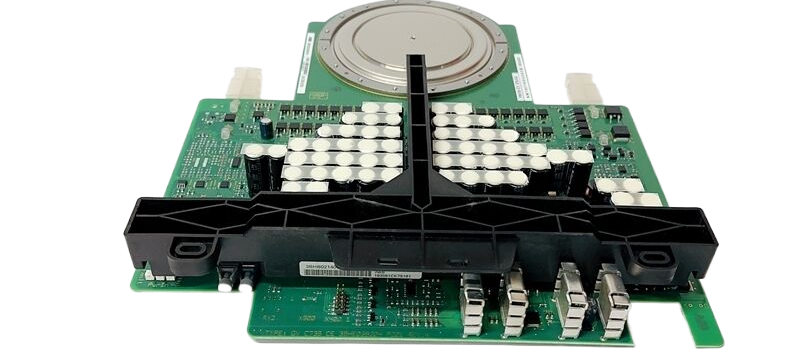ABB GVC736CE101 High Performance AC Inverter
Product Overview
The ABB GVC736CE101 high-performance AC frequency converter is a core equipment in the industrial drive field, dedicated to precise control of the operating status of AC motors. It integrates advanced power electronics technology and intelligent control algorithms, which can convert AC power with fixed frequency and voltage into output with flexible frequency and voltage adjustment, thus meeting the complex control requirements of various industrial equipment for motor speed, torque and other aspects. It is widely used in industrial automation, HVAC, elevator drive and many other fields, effectively improving system operation efficiency, reducing energy consumption, and ensuring the stability and reliability of equipment operation.
Working principle
The ABB GVC736CE101 module precisely regulates and controls the excitation current by receiving command signals from the control system. It adopts advanced control algorithms and circuit design, which can quickly and accurately adjust the magnitude and direction of excitation current according to the operating status and load changes of the generator, in order to maintain the stability of the terminal voltage of the generator and improve the stability and reliability of the power system.
Core functions
Accurate control of motor speed: Through advanced vector control technology, the motor speed can be precisely adjusted to achieve smooth start, stop, and stable operation at different operating speeds. In textile machinery, the motor speed can be precisely controlled according to the production process requirements of the fabric to ensure uniform spinning of the yarn.
Energy saving optimization: Built in intelligent energy-saving algorithms can adjust the output voltage and frequency in real time according to the motor load, reducing motor energy consumption. In variable load application scenarios such as fans and pumps, by adjusting the motor speed reasonably, unnecessary energy consumption can be reduced, significant energy-saving effects can be achieved, and enterprise operating costs can be lowered.
Multiple control mode switching: Supports various control modes such as V/f control, vector control, direct torque control, etc. Users can flexibly choose according to different motor types and application scenarios to meet complex industrial control requirements. In crane applications, vector control mode can provide precise torque control for the motor, ensuring smooth lifting and lowering of heavy objects.
Fault diagnosis and protection: Equipped with a comprehensive fault diagnosis system, real-time monitoring of the operating status of the frequency converter. Once overcurrent, overvoltage, overheating, undervoltage and other faults are detected, the protection mechanism is immediately triggered, the output is stopped and an alarm is triggered. At the same time, detailed fault information is recorded for maintenance personnel to quickly locate and eliminate faults, improve equipment maintenance efficiency, and reduce downtime.
Precautions
Installation environment selection: It should be installed in a well ventilated, dry, non corrosive gas, away from strong electromagnetic interference sources, and at a suitable ambient temperature. Avoid installation in damp, dusty, high temperature (exceeding the maximum allowable temperature of the equipment) or low temperature (below the minimum allowable temperature of the equipment) environments to prevent environmental factors from affecting equipment performance and service life.
Electrical connection specifications: Strictly follow the product manual for electrical connections to ensure that the input and output cables are securely and correctly connected, avoiding issues such as looseness, short circuits, and open circuits. Pay attention to the correct phase sequence of the power supply to prevent motor reversal or equipment damage caused by incorrect phase sequence. At the same time, it is necessary to ensure reliable grounding to ensure the safety of equipment operation and personnel safety.
Careful parameter setting: When setting parameters, it is necessary to fully understand the application scenarios and motor characteristics of the equipment, and carefully set various parameters according to actual needs. Avoid setting incorrect parameters that may cause abnormal device operation, such as motor failure to start, unstable speed, overload, and other issues. For unfamiliar parameters, it is recommended to consult professional technicians or refer to detailed product manuals.
Daily maintenance: Regularly clean the frequency converter, remove surface dust and debris, and prevent dust accumulation from affecting heat dissipation and electrical performance. Check whether there are signs of aging or damage to the connecting cables, and replace the damaged cables in a timely manner. Regularly monitor the operating temperature, current, and other parameters of the equipment, compare them with normal operating data, and promptly identify potential faults and hidden dangers. At the same time, according to the operating time and usage environment of the equipment, regularly inspect and replace vulnerable parts to ensure long-term stable operation of the equipment.
Similar model supplement
ABB GVC737CE101: Compared to GVC736CE101, GVC737CE101 has an improved power level and can adapt to higher power motors, suitable for industrial scenarios with higher driving power requirements, such as large mining equipment, high-power fans and pumps. In terms of control performance, the algorithm may have been further optimized to achieve more precise torque control and faster dynamic response speed, meeting the demanding requirements for equipment operation accuracy and fast start stop in applications.
ABB GVC735CE101: This model has a slightly lower power range compared to GVC736CE101, and is more focused on small industrial equipment and cost sensitive application scenarios. In terms of functional features, the core motor control and energy-saving functions are retained, while the volume design is more compact, making it easy to install in equipment control cabinets with limited space, providing an economical and practical driving solution for small automated production lines, small HVAC systems, etc.








